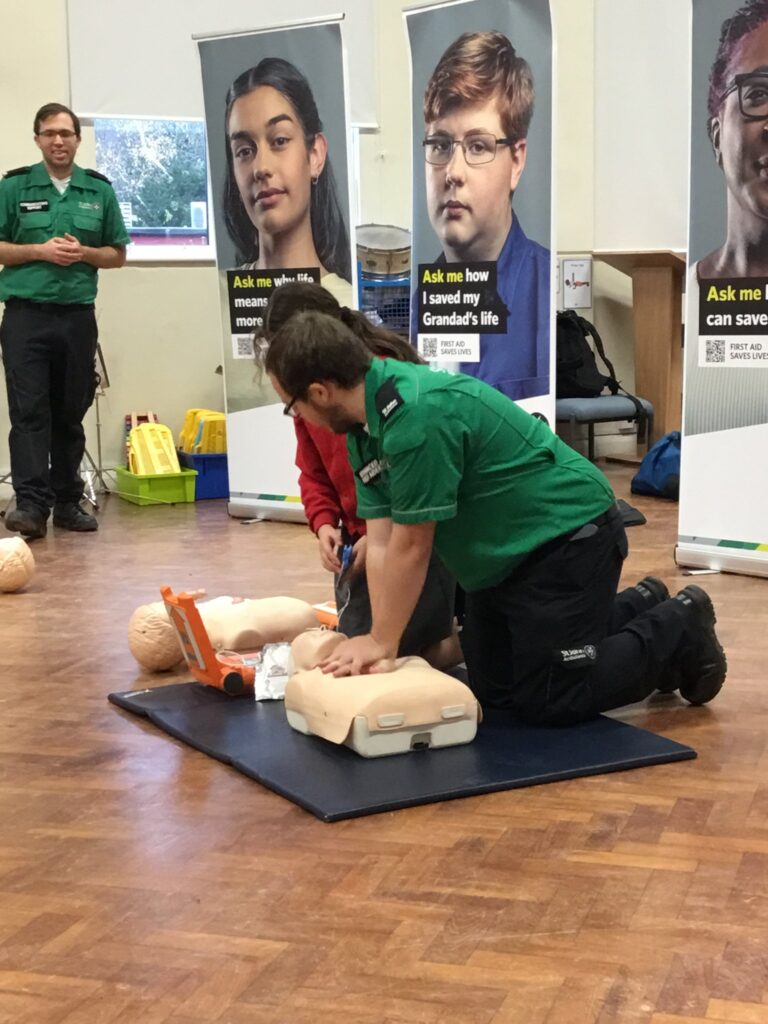St John Ambulance issue festive first aid advice

Festive Elf & Safety
St John Ambulance’s fool-proof first aid for a ho, ho, ho happy holiday
It’s beginning to look a lot like Christmas…. and to ensure a safe and healthy festive season, St John Ambulance is sharing a sack full of first aid advice to prevent accidents spoiling
the celebrations. The health and first aid charity are also urging everyone to ‘slow down’, as preventable mishaps often happen when we are rushing around.
St John Ambulance Medical Director, Lynn Thomas said, “The festive period is a joyful time but should come with a ‘health warning’ with the number of things that could go wrong …the
DIY decorations, hordes of people under one roof, excessive eating and drinking, and new toys and gadgets to choke on or trip over.
She added, “And, unfortunately it is often the young and elderly who are at increased risk of a Christmas first aid incident especially with choking on finger foods or children putting
small toy pieces in mouths. But the good news is that if you are all together, there is more chance of someone intervening, especially if they know first aid. We hope our first aid tips will get people up to speed before the festivities begin.”
Get a handle on candles
Christmas is the time of year most fire related incidents happen, with Government 2022 figures showing candle fires increasing by 7% in 2022 and crews tackling 940 fires, the highest
figure since 2010 *
·
Candles – don’t leave them unattended and do blow them out before you go to bed.
·
Make sure they are in suitable non-plastic holders/containers and keep away from any decorations/cards/curtains.
·
Keep candles, heaters and fires away from Christmas cards, wrapping paper and decorations
·
If you have small children or elderly guests – consider LED candles instead.
What to do if you do get a burn:
·
Move the person away from the heat and danger
·
Start cooling the injury as soon as possible. Place the burn or scald under cool water for
20 minutes minimum or until the pain goes away.
·
If the burn is
deep, or larger than the person’s hand,
on their face, hands, feet, intimate area or the casualty is a child – call 999 immediately
·
Remove jewellery and clothing around the area, unless stuck to the burn
·
Cover the burn loosely, lengthways with kitchen film to help
prevent infection and keep it clean
·
Don’t burst
blisters
·
Monitor and treat for shock if necessary
Smoke inhalation:
·
Move them away from the smoke
so they can breathe in some fresh air
·
Help them
sit down in a comfortable position and
loosen any tight clothing around their neck
to help them breathe normally
·
If they don’t recover quickly,
call
999 for an ambulance or 112 for urgent medical advice. Keep them calm whilst they are waiting
Deck the halls – but avoid the falls
Nobody has Christmas crutches on their wish list if it can be avoided, so follow these simple tips…
·
Take your time putting up decorations – rushing can lead to trips, falls and sprains
·
Don’t go up to the loft to retrieve tinsel and baubles alone – get some help from a family member, friend, or neighbour.
·
Don’t cut corners by standing on chair or stools, and if you have a stepladder – use it.
What to do if you fall
Look out for pain and tenderness, swelling and bruising and difficulty moving the area, especially if it’s a joint.
·
R – Rest the injured part. Help
them to sit or lie down
·
I – Apply an ice pack
or cold compress such as frozen peas wrapped in a tea towel for around 20 minutes
·
C
– Comfortable support. Use blankets, cushions to support the injury
·
E – Elevate the injured
part
Scary fairy lights
De-tangling fairy lights scores high on the festive stress test and is not much fun, but neither is getting a shock from lights on the blink…
·
Once you’ve untangled them check for damaged or frayed cables – and if you do find any damage, it’s better to be safe than sorry, so recycle
them and stick to tinsel, or buy a new set.
·
Check they work before putting up and if you do have a real Christmas tree, always unplug lights before watering the tree to reduce the risk
of electric shocks
·
Double check any exterior lights are safe and designed for outdoor use and keep plugs/transformers indoors
What to do if you do get an electric shock, burn, or go into cardiac arrest
·
Move the person away from the electrical source. You may be able to stand on some dry insulating material (such as a plastic mat or wooden
box) and use a broom handle or wooden pole to push the casualty’s hand or foot away from the source.
·
If it’s not possible to break contact using a wooden object, loop some rope around the underneath of the casualty’s arms or ankles and pull
them away from the electrical source.
·
Do not touch the casualty until they are clear of electrical source.
·
Once you’re sure the contact has been broken between the casualty and the electrical source, perform a
primary survey
https://www.sja.org.uk/get-advice/first-aid-advice/how-to/how-to-do-the-primary-survey/and
treat any injuries.
Burns – see above
Cardiac arrest:
·
Check for a response – gently shake the person’s shoulders, and talk to them or ask a question
·
If there is no response – shout for help an open the airway
·
Gently tilt the head – the mouth should fall open. Lift the chin
·
Check breathing – look, listen and feel for signs of breathing for no more than 10 seconds
·
If they are not breathing call 999/112 for emergency help
·
Kneel beside the casualty, level with their chest. Place the heel of one hand directly in the centre of the chest, put your other hand
on top, interlock fingers.
·
Begin chest compressions – lean over the casualty, with your arms straight and press down vertically on the breastbone (about 2-3 inches).
Release the pressure but do not take your hands off the chest.
·
Repeat the rate of 100-120 per minute (think of the beat to Staying Alive) until emergency help arrives, or the casualty starts coughing,
breathing, or talking.
Toy Gory …
Anyone who has ever stepped barefoot on a tiny building block or small plastic toy rarely does it twice, but to prevent inflicting pain on unsuspecting relatives and friends,
and avoiding trips, keep floorspace tidy!
·
Be extra cautious around small button batteries which can look like shiny sweets and are dangerous if swallowed. If a battery is accidentally
swallowed, the casualty should be taken to the nearest A&E as soon as possible
·
Tidy away new toys to a corner when not being played with –
especially small brightly coloured building blocks and hard to see toys as well as wires and stray controllers to prevent a tumble and a trip to A&E
·
Have scissors to hand for opening tough packaging and only let adults/older children use them
·
Make sure gifts to children are age appropriate – and will not be eaten or become a choking hazard
What to do if someone starts choking…
·
Ask them if they can breathe or speak, they may be able to clear their own throat
·
Encourage them to cough
·
For a choking adult –
help them to lean forwards, supporting their upper body with one hand. With the heel of your other hand give them five sharp back blows between
their shoulder blades. After each back blow, check their mouth and pick out any obvious obstruction.
·
Give five abdominal thrusts – stand behind them and put your arms around their waist. Place one hand in a clenched fist between
their belly button and the bottom of their chest. With your other hand, grasp your fist and pull sharply inwards and upwards up to five times. Check their mouth again, each time.
·
If the blockage still hasn’t cleared, call 999.
·
If they become unresponsive, prepare to start CPR
Hell’s Kitchen!
Feeding a horde of relatives and friends can be stressful…. Prepping as much as you can in advance (i.e., the night before) saves time as you will have a clear idea of cooking times
for everything, and a volunteer or two with set tasks such as plating up starters, laying the table, or helping to clear away!
·
Knife injuries – be careful when preparing vegetables and carving the meats to avoid
cuts
·
Food poisoning – in the stress of serving up Christmas dinner on time, corners may be cut. Make sure you allow plenty of time to cook your bird and stuffing
·
Singed eyebrows #notagoodlook – Don’t walk and talk with a flaming Christmas pud! Instead set light to it on a safe counter, away from little ones, or on
the festive table
·
Allergies – remind guests to let you know if they have allergies and if you have one yourself ensure you have antihistamines in your cupboard and carry your
epi pen for a more serious allergic reaction called anaphylaxis
What to do if you cut yourself:
·
Clean the wound by rinsing it under running water or using sterile wipes.
·
Pat the wound dry using a gauze swab and cover it with sterile gauze.
·
Remove the cloth or gauze covering the wound and apply
a sterile dressing or a large plaster.
·
Seek medical help if:
·
a wound won’t stop bleeding
·
a foreign object is embedded in the wound – like a splinter of wood or glass
·
the wound is from a human or animal
bite
·
you think the wound might be infected
·
you are unsure whether the casualty has been immunised against tetanus.
What to do if you suspect anaphylactic shock:
·
Call 999/112 for help and tell them you suspect anaphylactic shock
·
If the casualty has an adrenaline auto-injector (epi pen) help them to use it
·
Pull off the safety cap and holding it with your fist, push the tip firmly against the casualty’s thigh until it clicks, releasing the medication (it
can be delivered through clothing)
·
Hold in place for ten seconds (follow the instructions on the device), then remove
·
Help the casualty sit up, in a position that best relieves breathing difficulty. If they are pale, with a weak pulse, help them to lie down with their
legs raised
·
If they have more than one EpiPen, Repeated doses of adrenaline can be given at 5-minute intervals if there is no improvement, while waiting for help
to arrive
Dear Santa…. All I want is a stress-free Christmas!
It is
the most wonderful time of the year for many, but it can also be pressured and sometimes feel overwhelming… Remember things do not have to be perfect!
What to do if you feel a panic attack coming on:
·
Do not breathe into a brown paper bag – it may aggravate a more serious illness
·
Panic attacks can be terrifying for the casualty. Be kind, reassure them and lead the casualty to a quiet place so they can regain control of their breathing
more easily
·
If they are breathing too fast, coach their breathing and attempt to slow it down. Ask them to breathe in for 5 seconds, hold for 5 seconds and breathe
out for 5 seconds. Repeat this until their breathing calms to a normal rate.
·
Encourage them to seek medical advice on preventing panic attacks and controlling them in the future. If you are concerned that the casualty is not getting
better, or you cannot calm their breathing, call 999/112 for an ambulance.




